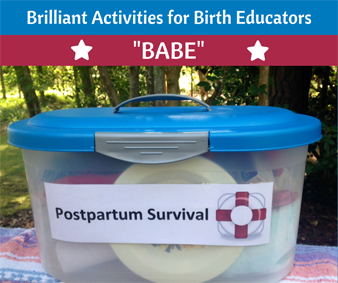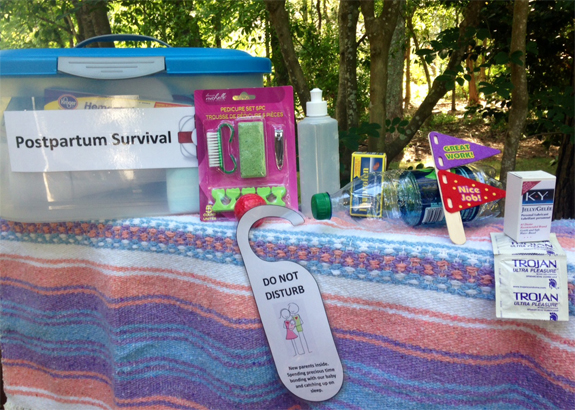Series: Brilliant Activities for Birth Educators - Postpartum Survival Kit - Helping Families Be Ready for Life with a Newborn
By: Sharon Muza, BS, LCCE, FACCE, CD/BDT(DONA), CLE | 0 Comments
By Cara Terreri, LCCE
May's Brilliant Activities for Birth Educators idea is all about the postpartum period. Lots of families don't realize that good childbirth classes not only prepare families for the labor and birth but can be a wealth of information about the first weeks with a new baby. Today on Science & Sensibility, Cara Terreri, LCCE shares her classroom activity to help families get ready for what happens after the birth - when they bring that new little one home. - Sharon Muza, Science & Sensibility Community Manager
Introduction
The postpartum period is an important component of childbirth education. As we know, preparation for the birth of a child isn't enough. And unfortunately in our culture, postpartum needs aren't given a lot of attention, which means that parents often feel unprepared, confused, and frustrated during the early days and weeks after baby comes home.
For my childbirth classes, I developed a fun and interactive activity to introduce and discuss the many topics related to postpartum. The exercise can be a stand-alone activity (in a refresher childbirth class) or used as an opener to more in-depth activities and lessons on postpartum in an entire series. My inspiration for creating the "Postpartum Survival Kit" was the wonderfully humorous "Postpartum Robe," a trademark teaching tool from Teri Shilling, MS, CD(DONA), IBCLC, LCCE, Passion for Birth founder and Lamaze educator, as well as Lamaze Childbirth Educator Seminar trainer.
The Postpartum Survival Kit (PSK) consists of a large plastic container with lid (mine also includes a handle, which helps for easy transport), and includes 23 items representing different issues or experiences a family may encounter during the postpartum period. The items represent everything from the physical recovery after birth (peri bottle, thick menstrual pad, and hemorrhoid cream) to emotional issues, like the importance of finding "me time" and postpartum mood disorders.
How It's Used
In my classes, after introducing the topic of the postpartum period, I bring out the PSK, pass it around, and instruct families to take out 2-3 items (depending on the number of students in class). I then introduce the PSK and talk about how the different items represent typical encounters and issues during the postpartum. We then go around the room and each couple is asked to share the items they pulled and offer an explanation of their significance. Some items are more obvious, like the sleep mask for the importance of getting sleep when you can; some elicit giggles and awkward moments, like the KY jelly which represents the possible need for vaginal lubrication during intercourse if the parent is breastfeeding; and some items are confusing, like the mini manicure kit (taking "me time") and the red golf ball (size of postpartum clots, what's normal and what's not).

When students share their items, I jump in when they (or the other students) cannot accurately describe the item's meaning. I also open the floor for discussion with open-ended questions like "How would you cope?" and "What kind of support would you need if this should happen to you?" and "Who could you call on for help?" Depending on the size of your class, this exercise can take up a good amount of time, so be sure to plan appropriately and be prepared to reel in side discussions should it get off course.
Takeaways
Parents in my classes really enjoy this exercise. I get a lot of laughs, bewildered looks, and "lightbulb" moments. It's always interesting to see how often the non-birth parent accurately describe the significance of items in this exercise - there have been many moments where the pregnant person is stumped, but the partner knows. In these instances, the exercise provides reassurance to both parents that the knowledge on what to expect during postpartum is intuitive. Additionally, I have found that this tangible exercise helps reinforce learning and memory when we talk more in depth about postpartum issues later in the class.
Modifications
The PSK exercise can be modified in several ways. I've used it in coordination with a worksheet, which could also be turned into a competition between families. If using in a private class, you can have each family member take turns with each new item. You could also use the exercise as an interactive teach-back. Ask each family to take out 2-3 items, learn about their significance (offer assistance if they are completely stumped), and then return to the next class and teach the other students.The PSK also could be replicated for use in teaching the stages of labor and breastfeeding. Create a similar, smaller kit for each stage of labor and/or breastfeeding and begin the segment with the kit. For example, a Transition Kit may include a focal point, washcloth, water bottle, and mini bullhorn (to signify the "take charge" routine).
Contents & Creating Your Own
The fun part about creating a PSK is making it uniquely your own! Some of the items will naturally be the same (lochia pad, hospital underwear, peri bottle, breastfeeding pads, for example), but others are limited only by your creativity! Consider the ways in which you can demonstrate postpartum mood disorders, changing emotions, dividing up hours in the day, eating nutritious food, sleep, etc. Items included in my Postpartum Survival Kit are:
- Water bottle - keeping hydrated
- Hospital underwear and pad - postpartum bleeding
- Peri bottle, Dermaplast, and ice pack - perineal healing
- Elastic abdominal brace - cesarean healing and core strengthening
- Plate with balanced meal - postpartum nutrition
- Ibuprofen - normal aches and pains
- Hemorrhoid cream - a not uncommon postpartum issue
- Stool softener - this is an important concern for many!
- KY Jelly - lubrication issues
- Condoms - postpartum fertility/birth control
- Eye mask - getting sleep
- Small red balloon paired with giant red balloon - involution, postpartum tummy
- Hand mirror with puzzled/confused face - postpartum mood disorders ("I don't recognize myself")
- Laminated speech bubble with "helpful" advice - dealing with influx of family/friend advice
- Cloth breastfeeding pads - leaking nipples
- Stuffed heart toy with wide open arms - finding and accepting support
- Do not disturb door hanger - limiting visitors is ok; family time is important
- Small baby doll with a heart and question mark on her tummy - conflicting emotions a baby often brings
- Encouragement flags - encourage and praise your partner
- Manicure kit - making time for yourself
- Pill box modified to read -house, partner, work, baby care, errands, etc- and filled with 24 beads, divvied up into the different compartments - how will you divide your time
What else might you add to your customized Postpartum Survival Kit? There are many ways to teach about adapting to and surviving the postpartum weeks. How do you teach about the postpartum period in your childbirth classes? What activities have you found effective? Share with all of us in the comments section. If you have a "BABE" to share in future posts - please contact me and let's talk. - SM
Note/Disclaimer: The use of the acronym "BABE" (Brilliant Activities for Birth Educators) is not affiliated with, aligned with or associated with any particular childbirth program or organization.
About Cara Terreri, LCCE
Cara is a Lamaze Certified Childbirth Educator, doula, and site administrator for the Lamaze parent blog, Giving Birth with Confidence. She teaches and works in Myrtle Beach, SC, where she lives with her husband and three children. You can learn more about Cara at Simple Support Birth.
Published: May 25, 2015
Tags
Childbirth educationPostpartumCara TerreriLamaze EducatorsProfessional ResourcesBabies